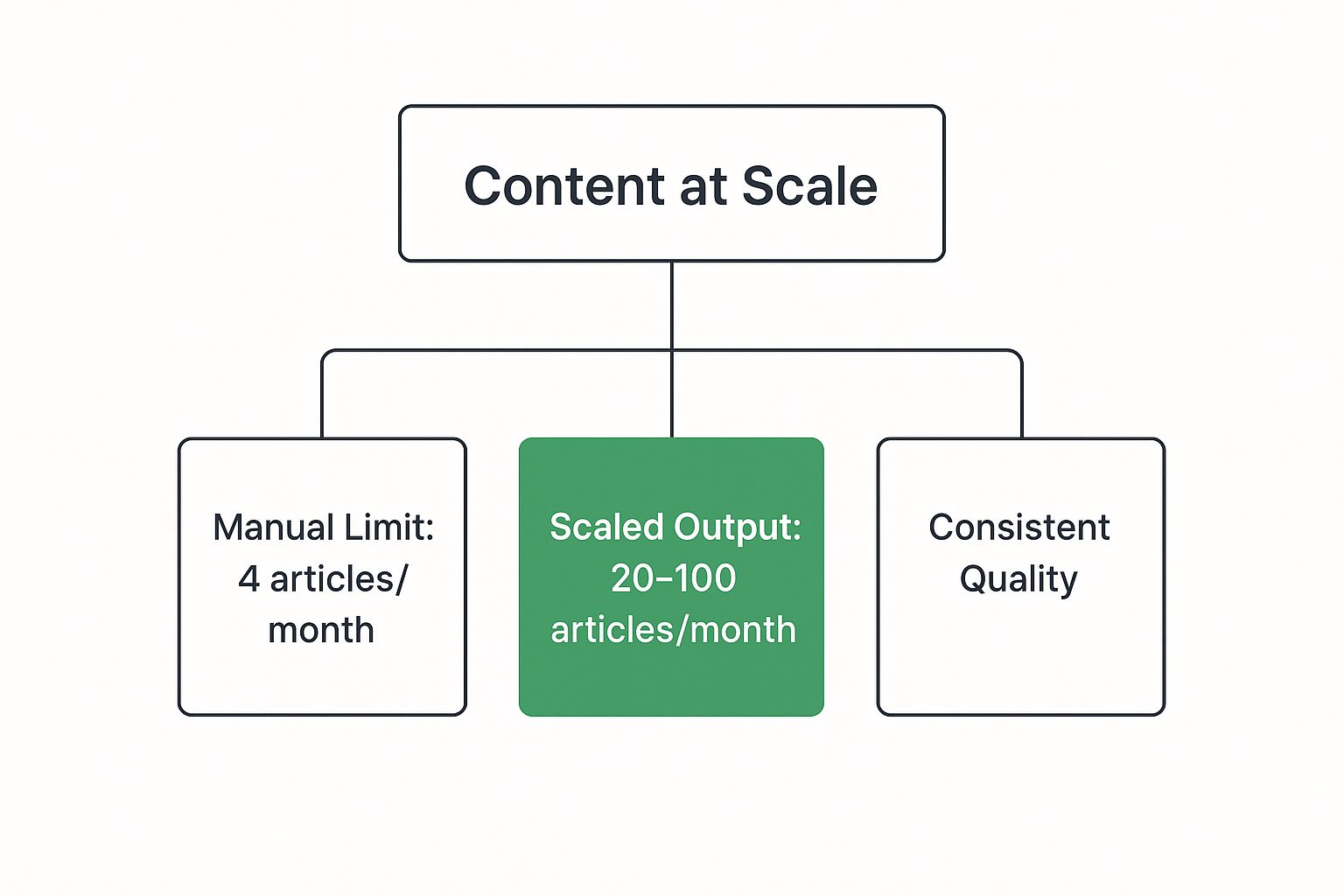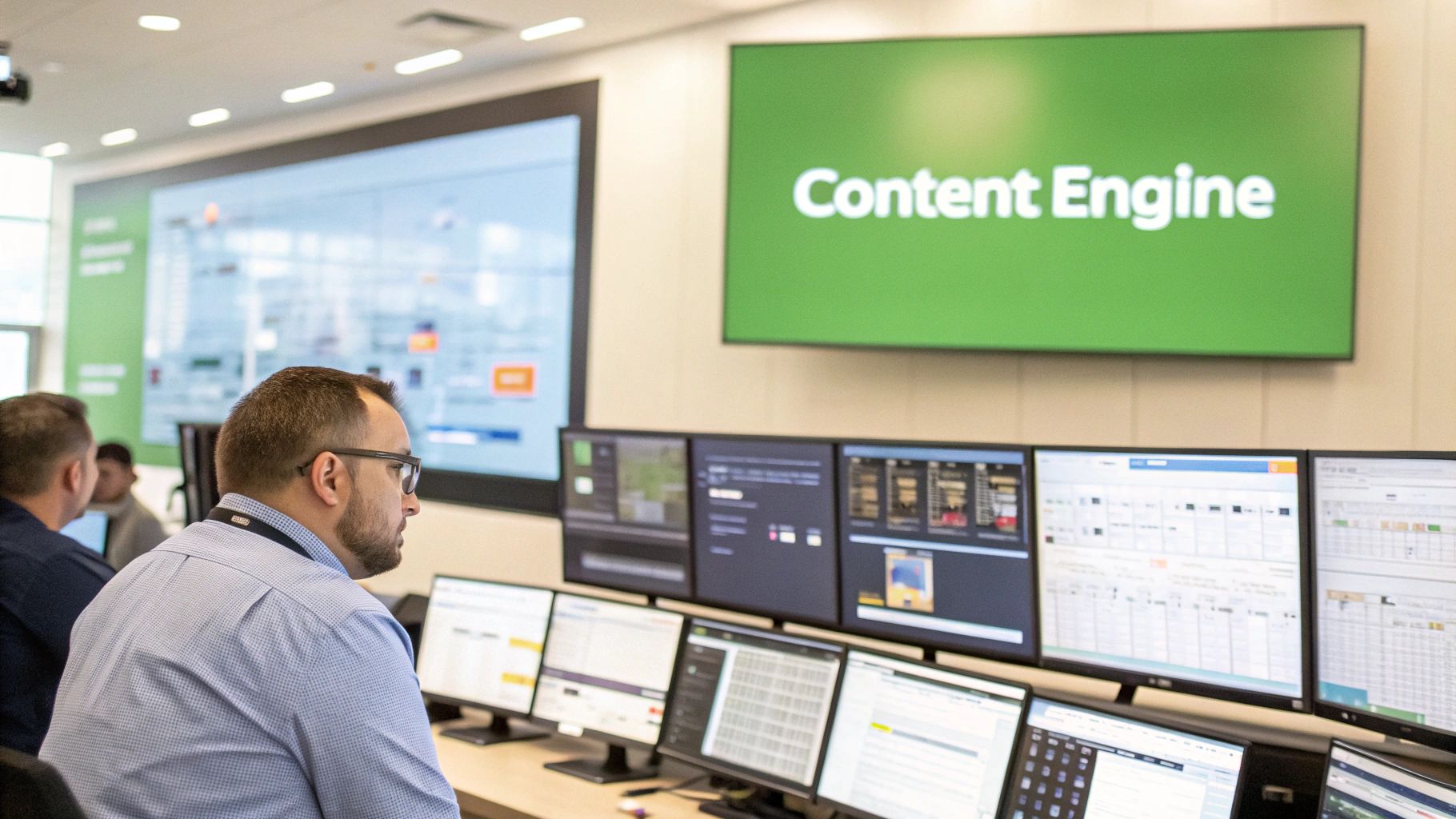
A Practical Guide to Content at Scale
October 15, 2025
Content at scale is a system for producing a high volume of quality, on-brand content without burning out your team. It’s the difference between an artisanal, one-off creation process and a well-oiled assembly line that keeps quality high while ramping up output. In a noisy market, this is how you stay visible.
What Does Content at Scale Actually Mean?
Think about an artisan baker who crafts a few perfect loaves every morning. Now, picture a modern bakery that produces thousands of equally delicious loaves every day. Both make great bread, but only one can meet widespread demand. That's the core idea behind content at scale.
It’s a common myth that you have to choose between quantity and quality. Scaling content isn’t about pumping out generic articles or spamming social media. It’s about building a reliable engine for production—one powered by smart workflows, clear guidelines, and the right tech. This engine ensures every single piece of content meets your standards, no matter how many you create.
Moving Beyond Manual Limits
For a lot of marketing teams, content creation is a serious bottleneck. A small team might be able to realistically produce, say, four high-quality blog posts a month. That’s great, but it severely limits their reach and ability to compete for search rankings. A scaled system shatters that ceiling.
The infographic below shows the jump from a manual process to a scaled one, highlighting how much output can increase while keeping quality consistent.

As you can see, the goal is to shift from just a handful of articles per month to a system that can produce anywhere from 20 to over 100 pieces of content without quality taking a nosedive.
This kind of velocity lets you target more keywords, speak to different audience segments, and build topical authority way faster than you could before.
Why Scaling Is No Longer Optional
Today, your visibility is directly tied to how consistently you publish valuable content. Brands that show up frequently are rewarded with better search rankings, more engagement, and stronger customer loyalty. In fact, research shows that 97% of marketers believe creating personalized content at scale is possible, even if many still find the idea intimidating.
The key is to reframe the problem. Don't ask, "How can we write more?" Instead, ask, "How can we build a system that produces more?" This system usually relies on three things:
- Standardized Processes: Repeatable workflows for everything from keyword research and content briefing to editing and publishing.
- The Right Tech: AI writing assistants, project management tools, and analytics platforms that automate the grunt work and speed up production.
- Clear Roles: Defining who does what to avoid bottlenecks and keep things moving smoothly from one stage to the next.
The demand for content is endless, and old-school production methods just can't keep up. Scaling isn’t just about making more stuff; it’s about creating a sustainable system that keeps your brand relevant and consistently meets your audience's expectations.
Ultimately, content at scale is what allows you to go from being a small voice in a crowded room to a leading authority in your industry. It’s the framework that supports real growth by making sure your message gets to the right people, at the right time, every single time.
The Blueprint for a Content Scaling Engine

Getting to content at scale doesn't just happen. It’s an engineered outcome. Think of it like building a high-performance engine—you can't just toss a bunch of parts together and hope for the best. You need a solid blueprint where every component works in perfect harmony.
This blueprint is built on four pillars: Technology, People, Process, and Performance. Get these four areas right, and you’ll have a powerful, reliable system for creating great content, consistently and at volume.
The Role of Technology
Technology is the force multiplier in your content engine. The right tools don't just speed things up; they automate the tedious, repetitive work and free up your team to be more creative. For any modern content operation, this usually means a few key pieces of software.
- AI Writing Assistants: Tools like Natural Write are at the center of it all. They help generate first drafts, brainstorm ideas, and polish copy, drastically cutting the time it takes to get from a blank page to a finished piece.
- Project Management Software: Platforms like Asana, Trello, or Monday.com give you a single source of truth for your entire workflow. Everyone can track progress, hand off tasks, and see bottlenecks before they become a problem.
- Digital Asset Management (DAM): A good DAM system keeps all your images, videos, and brand assets organized and easy to find. It saves countless hours that used to be wasted just searching for files.
These tools form the backbone of your scaling efforts, letting your team focus on strategy and ideas instead of getting bogged down in manual admin.
The People and Processes
Even the slickest tech is useless without the right people and processes steering it. This is where your operational strategy comes in, ensuring every piece of content is consistent, efficient, and on-brand.
It all starts with a documented content strategy. A good plan gives everyone clarity and keeps them working toward the same goals. For a really solid foundation, check out this ultimate content marketing strategy template.
"A machine is only as good as its operator. In content scaling, your processes are the instructions, and your people are the skilled operators who ensure everything runs smoothly and produces a quality result."
With a clear plan in place, you can define specific roles for your team—strategists, writers, editors, distributors. This eliminates confusion and creates clear ownership, which is crucial for a smooth-running production line. You can learn more about this in our guide on how to develop a content strategy.
Let's look at how these approaches stack up.
Comparing Manual vs Scaled Content Production
| Aspect | Manual Approach | Scaled Approach |
|---|---|---|
| Output Volume | Low; a few high-effort pieces per month. | High; dozens or hundreds of pieces per month. |
| Speed | Slow; weeks or months from idea to publish. | Fast; days or even hours for a single piece. |
| Consistency | Varies based on individual writer and editor. | High, thanks to templates and style guides. |
| Cost Per Asset | High, due to intensive human labor. | Low, due to automation and efficient workflows. |
| Team Focus | Primarily on writing and editing each piece. | Strategy, optimization, and creative direction. |
| Tools | Basic (e.g., Google Docs, email). | Integrated (e.g., AI writers, PM software, DAMs). |
The difference is pretty stark. A scaled approach isn't just about doing more; it's about operating smarter.
The Performance Feedback Loop
The final pillar is performance. This is what turns your content engine from a static machine into a system that learns and improves over time. It’s all about measuring what’s working, understanding why, and feeding those insights back into your process.
This isn’t just about glancing at page views. It’s about digging into deeper metrics like conversion rates, time on page, and search rankings to see what actually connects with your audience. This data-driven feedback loop helps you make smarter decisions, so you can double down on winning topics and formats while pulling back on what’s not working.
The push toward strategic content is clear. By 2025, an estimated 91% of brands will use content marketing, and those with a documented strategy see a 33% higher ROI. The efficiency of AI is also undeniable—92% of large marketing teams now use it to scale their content efforts.
How to Avoid the Common Pitfalls of Scaling

Shifting to a high-volume content model is a game-changer, but it’s not without its traps. You can’t just turn up the production dial and expect everything to run smoothly. If you’re not careful, you can end up with a whole new set of problems.
The secret to scaling successfully is to see these hurdles coming and build systems to get around them before they start to undermine your work. It all comes down to protecting three things: your brand voice, your content quality, and your team.
Protecting Your Brand Voice
When you start producing content at a rapid pace, your unique brand voice is often the first casualty. With multiple writers, editors, and AI tools in the mix, it’s easy for your content’s personality to get watered down or feel inconsistent.
Suddenly, things start to sound a little different from one article to the next, and that distinct voice your audience recognizes begins to fade.
The fix is to get your brand voice out of your head and onto paper. Turn it from an abstract idea into a concrete, documented system that anyone—or any AI—can follow.
- Build a Real Style Guide: This needs to go way beyond basic grammar rules. Define your brand's tone (e.g., witty but not sarcastic), its personality (helpful, confident), and even specific words to use or avoid.
- Create Master AI Prompts: Craft a set of detailed, pre-approved prompts for your AI tools. These should include clear instructions on tone, perspective, and key messaging to make sure even the first drafts come out sounding like you.
When you externalize your voice into clear rules, you create a North Star for every single piece of content.
Maintaining Content Quality
There’s a common fear that producing more content means producing worse content. It’s a valid concern. When speed is the priority, quality control can easily fall by the wayside, and you risk publishing articles that are thin, inaccurate, or just plain boring.
Your best defense here is a tiered review process. Instead of one person trying to catch every little mistake, you create a multi-stage system of checks and balances.
A content assembly line without quality control is just a machine for making mistakes faster. The point of scaling isn't just to make more stuff—it's to make more of what actually works.
Here’s a simple but powerful quality assurance (QA) workflow:
- AI-Assisted First Pass: Use tools to handle the basics like grammar, spelling, and plagiarism checks. This takes care of the low-hanging fruit and lets your human editors focus on what really matters.
- Expert Gut-Check: For technical or specialized topics, have a subject matter expert (SME) do a quick review to verify accuracy and depth. A simple checklist can make this step fast and painless.
- Final Polish Edit: A skilled editor gives it one last look, focusing on flow, voice, and readability. This final human touch is what separates good content from great content.
This layered approach makes quality control manageable and ensures every piece that goes out the door meets your standards.
Preventing Team Burnout
Finally, let’s talk about the human cost. Pushing your team to produce more without giving them better systems is a one-way ticket to burnout. When people are overworked and overwhelmed, creativity dries up, deadlines get missed, and the work suffers.
Sustainable scaling is about creating efficiency, not just demanding more effort. It’s about giving your team the leverage they need to do more without working longer hours. This is where your investment in solid processes and smart technology really pays off.
Look for ways to remove friction from the workflow. Automate the repetitive stuff—like formatting, posting to social media, or pulling initial research. When you let technology handle the grunt work, you free up your team to focus on the creative, strategic tasks that humans do best.
That’s how you build a content engine that’s not just productive, but sustainable for the long haul.
Your Step-by-Step Content Scaling Workflow

Alright, with a solid framework in mind, it’s time to get practical. Building a system for content at scale isn’t about magic; it’s about a clear, repeatable workflow that turns your big-picture strategy into actual articles and posts.
Think of it like a well-oiled assembly line for your content. Each station has a purpose, a clear owner, and a finished piece that feeds right into the next step. This is how you move from chaotic, last-minute creation to a smooth, predictable process.
Stage 1: Strategic Planning and Briefing
Everything good starts with a plan. Seriously. Rushing into writing without a clear direction is the fastest way to create content that nobody reads. This first stage is all about laying the groundwork before a single word is written.
It all begins with strategic keyword clustering. Instead of chasing random keywords, you group related terms around a central topic. This helps you build topical authority—a huge deal for modern SEO—by creating a web of interconnected content that answers every possible user question.
Once you have your clusters, you build out detailed content briefs. A great brief is the blueprint for your article. It should include:
- The main topic cluster and target keywords
- Who you're writing for and what keeps them up at night
- The key questions the content absolutely must answer
- A rough outline with suggested H2s and H3s
- Ideas for internal and external links
This brief becomes the single source of truth for everyone involved, making sure your writers, editors, and even AI tools are all on the same page from the get-go.
Stage 2: First Draft Generation
With a solid brief in hand, it's time to create. This is where a hybrid approach—blending human insight with AI speed—really shines. The goal here is to get something on the page quickly. It doesn't need to be perfect.
You can hand the brief to an AI writing assistant, like Natural Write, to generate a structured draft in minutes. This instantly beats the "blank page" problem and gives you a solid foundation to work from. Or, a human writer can hammer out the initial draft, maybe using AI to help with research or flesh out a few sections.
The point of a first draft is just to get the ideas down. It’s the raw clay you’ll shape and polish later. Don’t get hung up on perfecting every sentence. Just focus on covering the topic and making sure the flow makes sense.
This method dramatically cuts down production time, letting your team move from an idea to a working draft faster than you thought possible.
Stage 3: Human-Led Editing and Optimization
This is where the magic happens. A raw AI draft is never ready to publish. It needs a human touch to add nuance, nail the brand voice, and double-check the facts.
The editing process should have a few layers. First, a subject-matter expert (SME) can give it a once-over for technical accuracy. Then, a skilled editor refines the copy for clarity, tone, and readability, making sure it sounds like you.
Finally, the content gets optimized for search. This means:
- Checking keyword usage to ensure it sounds natural, not stuffed.
- Writing meta titles and descriptions that make people want to click.
- Adding internal links to guide readers to other relevant content on your site. For a closer look at this, check out our guide on building an effective content creation workflow.
This human-led refinement is what turns good content into great content.
Stage 4: Distribution and Performance Analysis
Creating amazing content is only half the battle. You have to get it in front of the right people. Your distribution strategy should be just as systematic as your creation process.
That means repurposing your core content for different channels. A single blog post can become a dozen social media updates, a section in your email newsletter, a short video script, or a quick infographic. This approach squeezes every drop of value from each piece you create.
The numbers back this up. By 2025, an estimated 5.45 billion people will be on social media, with the average person using seven different platforms a month. That’s a massive audience, and 26.6% of users are there actively looking for products to buy.
The final step is closing the loop with performance analysis. Track your key metrics—traffic, engagement, conversions, rankings—to see what's resonating. Those insights then feed right back into your strategy, creating a cycle of continuous improvement that makes your content engine smarter and more effective over time.
How Natural Write Humanizes AI-Powered Content
Understanding the theory of content at scale is one thing. Actually putting it into practice is something else entirely. You need the right tools to bridge the gap between AI’s speed and genuine human creativity.
This is exactly where a platform like Natural Write comes in. It’s not just another content generator; it’s a humanization engine.
Think about a marketing team trying to launch a big campaign. They need a cornerstone blog post, a dozen social media updates, and a killer email newsletter—all spun from the same core idea. If they use a standard AI writer, they get generic drafts that sound like… well, like a robot wrote them. The output is fast but flat, and it takes heavy-duty editing to make it sound authentic.
Natural Write was built to fix that problem. It’s designed to take that raw, robotic AI output and inject it with the nuance, flow, and personality that actually connects with people.
Tuning Your Brand Voice
The single biggest risk in scaling content with AI is losing your brand’s voice. Natural Write tackles this head-on with powerful brand voice tuning. It doesn’t just create content; it refines it to match your specific style guide, making sure every single piece sounds like it came from your team.
For our marketing team, this means they can feed their AI-generated drafts into Natural Write and apply a pre-set brand voice profile. The platform then gets to work, adjusting the tone, word choice, and sentence structure. It transforms a bland, generic article into something that feels on-brand and real.
Scaling content successfully means your audience should never be able to tell a machine was involved. The goal is to make the technology invisible, so only your brand's authentic voice shines through.
This is a game-changer. It elevates AI from a simple drafting tool to a true partner in content creation, helping you maintain consistency across dozens or even hundreds of assets.
Streamlining Collaboration and Optimization
Beyond getting the voice right, producing content at scale requires a workflow that doesn't fall apart. Natural Write integrates collaborative tools that simplify the whole editing process. Team members can work together right inside the platform to review, tweak, and approve content, which means no more clunky back-and-forth over endless document versions.
This integrated system also comes with built-in SEO features. After humanizing the content, the team can optimize it for target keywords directly within the platform. This makes sure every blog post, social update, and email is not only on-brand but also ready to be found on search engines.
Just look at the entertainment and media industry for proof of how well this works. In 2024, global revenues in this space hit $2.9 trillion, largely driven by AI-enhanced production that keeps up with massive consumer demand. As PwC's global outlook shows, this industry proves that technology and strategic content are a winning combination, with forecasts predicting revenues will climb to $3.5 trillion by 2029.
Ultimately, Natural Write acts as a central hub where speed meets quality. A single idea can be efficiently expanded and refined into a multi-channel campaign, with every piece retaining that essential human touch that builds audience trust and keeps them coming back.
Measuring the True ROI of Your Content Engine
A powerful content engine is great, but it’s only as good as the results it drives. Pushing out a high volume of articles might look impressive, but without a clear way to measure its impact, you’re just making noise. To justify the investment in creating content at scale, you have to look past vanity metrics like page views and social media likes.
The real goal is to draw a straight line from your content to tangible business outcomes. We're talking about the numbers that actually matter to the bottom line: lead generation, conversion rates, and revenue. Think of it as building a bridge between your blog posts and your company’s financial health.
Moving Beyond Surface-Level Metrics
First things first: shift your focus from traffic to impact. Sure, high traffic is a nice start, but it doesn't tell the whole story. A single article that brings in ten high-quality leads is infinitely more valuable than ten articles that only generate clicks and bounces.
To really get a handle on ROI, you need to track essential content engagement metrics that reveal how people are actually interacting with your work.
Here’s what to zero in on:
- Conversion Rates: How many people take the next step after reading? Do they sign up for your newsletter, download an ebook, or request a demo?
- Lead Quality: Are the leads coming from your content the right fit for your business? This tells you if you're attracting the right audience.
- Sales Pipeline Influence: Can you trace a new customer back to a specific blog post they read early in their journey? This is where content proves its worth.
Proving ROI isn't just about showing that people saw your content. It's about demonstrating that your content influenced their decision to become a customer. This is the difference between an expense and an investment.
Building Your Content Performance Dashboard
A content dashboard is your command center for tracking all of this. It's the single place where raw data gets turned into a clear story about your content's performance. It should be simple enough for stakeholders to grasp in a minute, but detailed enough for your team to pull out actionable insights.
For a deep dive into setting this up, our guide on measuring content effectiveness gives you a step-by-step framework.
Ultimately, your dashboard should connect the dots between content production and business growth. When you can show how your scaled-up system is directly moving the needle, you don’t just prove your value—you build a case for the budget and buy-in you need to keep going.
Common Questions About Scaling Content
As soon as teams start thinking about producing more content, a few key questions always come up. Getting straight answers is the first step toward building a system for content at scale that actually works.
Let's clear the air on some of the most common ones.
What Does "Content At Scale" Really Mean?
It's easy to get hung up on a number. People think "scale" means hitting some magic, universal target, like 50 or 100 articles a month. But that’s not it at all. The real definition is completely relative to where you are right now.
Think of it as a significant leap in your team's output. If you’re currently managing to publish four great articles a month, scaling might be building a system to reliably create twenty. If you're already at twenty, your next leap might be one hundred.
The point of content at scale isn't hitting an arbitrary number. It’s about building a repeatable engine that shatters your old limits on output without ever letting quality slide.
Ultimately, "at scale" just means you're producing way more than you ever could manually.
Can Small Teams Actually Do This?
Absolutely. In fact, small teams and even solo creators are often the ones who get the most out of a scaled-up system. This whole game is less about headcount and more about having smart, efficient processes. A huge team with a chaotic workflow will get smoked by a tiny team with a dialed-in one.
It all comes down to creating repeatable systems and sticking to them. Here’s how small teams punch way above their weight class:
- Standardized Workflows: A documented process from idea to published post. It kills the guesswork and saves a ton of time.
- Content Templates: Having pre-built outlines and briefs ready to go makes the writing part faster and keeps everything consistent.
- Smart Tech: This is the force multiplier. Using an AI assistant like Natural Write to handle the heavy lifting of drafting and refining lets a small team operate like a much larger one.
These ingredients are what allow smaller players to go toe-to-toe with massive competitors—they just move faster and more efficiently.
Do I Have To Use AI To Scale Content?
Nope. While AI is an incredible accelerator, it's not a non-negotiable. The principles of scaling content have been around for a long time, well before modern AI tools hit the scene. You can definitely build a powerful content engine without it.
A non-AI scaling strategy relies on rock-solid processes, detailed templates, and getting really good at repurposing. That means turning one great blog post into a dozen social updates, a newsletter, and maybe even a video script.
But let's be honest: AI makes achieving high-volume scale dramatically easier for most people. It automates the grunt work, freeing up your team to think about big-picture strategy and get creative.
Ready to humanize your AI drafts and start scaling with confidence? Natural Write turns robotic text into authentic, on-brand content in one click. Try it for free and see how easy it is to produce high-quality content that sounds like you, every time.


